Episode Page | Direct link to Audio File | Listen on Spotify
The new data dashboard by the Joint Office of Homeless Services in Multnomah County provides a comprehensive and dynamic view of homelessness, enhancing transparency and accountability.
The Joint Office of Homeless Services introduced this data dashboard to consolidate various reports into a single, user-friendly platform. Lori Kelly, the planning and evaluation manager, explains, “We’re looking for a very user friendly site that has a lot of definitions. It has line charts and bar charts depending on what kind of data we’re sharing.” This dashboard will allow users to filter data by demographics, such as age, gender, and chronic homelessness, providing a detailed and nuanced understanding of the homeless population.
The dashboard will also track inflow and outflow, as well as output and outcome metrics for housing, shelter, and prevention services. Kelly noted, “The dashboard will also include output and outcome metrics on housing, shelter, and prevention, and so it will have everything ranging from shelter occupancy and a number of people being served in shelters all also filterable by demographics, as well as how many people were serving in prevention, how many people were serving in different types of housing, how many people are housed effectively, and how many people are waiting for housing inside our programs.”
Additionally, the dashboard will feature retention rates for those who have been housed, helping to assess the long-term success of housing initiatives. Kelly elaborated, “We track retention afterwards, and we can also figure out that they are no longer stably housed if they show up in asking for housing or in a shelter system.” This dynamic tool is designed to support both frontline workers and policymakers in making informed decisions and improving services.
The Joint Office of Homeless Services uses a by-name list to more accurately track and serve the homeless population, reflecting a more sophisticated and compassionate approach.
The by-name list, a key component of the data dashboard, offers a more accurate and comprehensive view of homelessness compared to the point-in-time count. Lori Kelly explained, “The by-name list is intended to be used for things like case conferencing and prioritizing people for services. And so it’s really looking at people who are actively engaging in the system and helping people understand and find people so they can do their work. This method ensures that the data reflects the real-time status of individuals experiencing homelessness, rather than just a snapshot on a specific night.
The by-name list also includes a 90-day inactivity policy, which helps maintain the accuracy of the data. Kelly stated, “If nobody has an interaction with a person for over 90 days, and they are not enrolled in a program, we assume they’re still homeless, but we put them into something called inactivity.” This approach ensures that the list remains current and useful for service providers, while also respecting the privacy and consent of individuals.
The by-name list is also designed to avoid stigmatizing individuals. Kelly emphasized, “We do not require people to give their legal name in order to be on this list. We do request or hope that they will give a name that allows them to be regularly found, meaning they can be Marilyn Monroe every time they talk to us.” This flexibility helps build trust and encourages more people to engage with the system, leading to better outcomes for those in need.
The concept of data excellence is central to the Joint Office’s approach to managing and reporting data. Lori Kelly defines data excellence as “moving towards a state of greater data maturity, which means we have a very robust quality assurance plan. We have increasingly larger amounts of programs and spaces in which we collect data, and we have protocols in place to make sure our data is up to date, accurate, and reflects the populations and the services that we’re serving.” This commitment to data excellence ensures that the information used to inform policy and service delivery is reliable and actionable.
The data dashboard reflects this commitment to data excellence by providing a clear and comprehensive view of the homeless population and the services provided. Kelly mentioned, “One other thing you will see is that we continue to increase the amount of people we’re housing and sheltering on a regular basis. I love seeing that. You can already see that in our system performance reports, but now you can see it all in one place.” This transparency is intended to build public trust and support for the ongoing efforts to address homelessness.
Furthermore, the Joint Office is working to ensure that the data is accessible and understandable to the public. Kelly added, “There will be glossaries so people understand what our terms mean. Sometimes they’re intuitive, sometimes they’re not, and we’re having them reviewed by a variety of communications experts to try to make them as easily digestible as possible.” This effort to make the data accessible underscores the Joint Office’s commitment to transparency and community engagement.
Episode Page | Direct link to Audio File | Listen on Spotify




